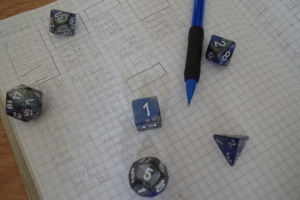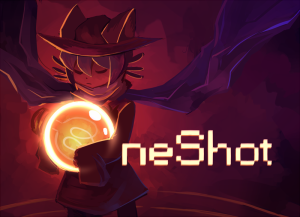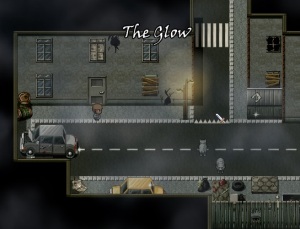In Which We Saved the World
There comes a time in every epic fantasy RPG when the world needs saving. At some point, the only thing that can stop evil from enveloping creation is a small team of axe-crazy warriors, reality-bending magicians, and half-breed misfits. The massed armies of powerful nations are inconsequential in the end. It all comes down to a boss fight between the players and the dark lord. If your RPG isn’t leading up to a confrontation like the one I described, it probably isn’t epic fantasy.
The stage was set in my Challenger campaign. My players had gathered the Ten Elemental Orbs and stormed Nostravor’s lair. Having accidentally released him from his prison, they sought a stronger magic that could overcome him before darkness enveloped the world. They embarked on a quest for an enigmatic artifact known as the gauntlet of Nargothrond. They slew a goddess and a dragon searching for it. The Five Kingdoms of Man were under siege. Time was running out—the Game Master was starting college at the end of August!

I found a Saturday that fit into all the players’ schedules to play one last adventure. In the weeks and days leading up to the event, I had to answer the age-old question for myself. How does one design a final boss battle that excites and challenges? How does one plan an encounter that the players will remember for the rest of their lives? How does one end an absurdly high-powered campaign on the most incredibly epic high note possible?
There were three things I wanted to incorporate as I planned my final encounter: high theatrics, interesting tactics, and insane quantities of damage. I began by brainstorming. Actually, it would be more accurate to say I began by daydreaming. It’s common in video games to ease into the final boss with a pre-final boss. This boss serves no purpose other than to emphasize how thematically and statistically powerful the real final boss is. So of course Nostravor needed a preboss. In fact, it would be even better if the pre-final boss came with a pre-pre-final boss, since I wanted Nostravor’s battle to be more narrative-driven than the rest of the encounter.
The blueprint I came up with was as follows:
1) Players think their way out of the end of the previous adventure (something that really shouldn’t have been a part of this particular encounter).
2) Players role-play through the final encounter’s herald.
3) Players demolish a troop of powerful monsters effortlessly to pump the player’s egos.
4) Players battle a brutal preboss with theatrical twists.
5) Players overcome the final boss while taking truckloads of damage and facing a moral dilemma.
I planned and plotted and wrote stats for every creature involved. Every enemy presented a pieceless puzzle, a set of written and unwritten strengths and weaknesses for my players to discover and create. The plot lines were ready to come together. Everything was set for an epic final encounter.
As any Game Master can tell you, however, the best plans to turn to ash and disappear on the wind the moment the players touch them. In my case, the plan needed amputations and tourniquets before the players even arrived—half of the party was an hour and fifteen minutes late.
Already behind schedule, we began. Wrapping up the last adventure took longer than I anticipated, but we had fun. Between the friendly fire and the improvised weapons, the party managed to escape from the sassy Book of Many Things with the Gauntlet. As they left the dungeon, they encountered an NPC whom they’d encountered previously on less than favorable terms. This time, however, she brought a gift—Artakha’s Journal. In this tome, they discovered more of the lore of the Gauntlet of Nargothrond.

With their knowledge and apprehensions of the Nargothrond’s Gauntlet deepened by this manuscript, the heroes hastened northward to confront Nostravor with the armies of Men and of Drow at their backs. (Note to self: avoid situations in which half of the party flies while the other half lags behind.) After discussing their battle plan with the generals of the six armies represented, the players entered a battle that dwarfed Helm’s Deep. At this point, they would have encountered two minotaurs, a behemoth, half a dozen samurai in flaming black armor, and and a darkly-cloaked figure with glowing hands, but all we had time for was the troop’s boss, Excalibur (the darkly-cloaked figure). Having the extra battle was handy, though—from now on, I think I’m going to design all of my adventures with extra encounters that can be picked up or dropped at will.
Excalibur’s damage (which she dealt every time a player missed an attack due to the somewhat arcane nature of Challenger) was 4d6 to match, a mechanic I devised for high-variable damage. The 4d6 are rolled, but only the dice that match other dice in the roll count. Note that the damage dealt by this method scales increases significantly from 4d6 to 5d6. This will become important later.
The players slew Excalibur pretty easily. Next up to bat was a black-scaled humanoid who breathed green smoke. When the players asked him what his name was, he answered, “You may call me death, for to you we are one and the same.”
In my Game Master’s notebook, he had a shield good for five hit points of each of the game’s ten elements. My idea was that the players would have to figure out that they had make an attack with each element to break his shield, at which point he would fall back on his own hit points. My players, however, would have none of this. After I told them that their attacks were damaging his shield and making it glow, they came up with their own diagnosis—the shield had to go. Two of my players, a healer from the stars and a powerful enchantress, affected this with a natural 19 and a natural 20 for a bubble that isolated Death from his shield. (We don’t play with very strict rules for magic.)
Miffed but far from without a plan, I informed them that
Death snapped his fingers and reached for Excalibur, whose corpse became a sword and flew into his hand (see what I did there?). Death was now wielding the previous boss as his off-hand weapon. The psychological impact of this was very satisfying.
My players were up to their usual game for the rest of the fight—fanning flames with wind magic, catching the boss’s sword, giving that sword to an earth golem—all while taking huge amounts of 5d6 to match glowing sword damage from the transformed Excalibur. Character after character fell below 0 hit points only to be revived again and again as Death’s wings burned and his arm got chopped off. At last he fell. The party was in tatters, and they hadn’t even begun the final battle.
Nostravor was waiting for them.
What the players knew was that Nostravor had absorbed the power of the Ten Orbs, leaving them empty husks, and that the Gauntlet of Nargothrond was a stupidly powerful artifact built to drain energy. What they didn’t anticipate was that the Gauntlet would affect the entire world, sealing magic away from every enchantment, mage, and creature. They didn’t have much choice, though—Nostravor was dealing 5d12 damage to a random party member at the end of every round. The heroes dealt well over a hundred points of damage in the time it took their leader to seal away each of the ten elements. I told everyone present to roll a final attack, and after totaling their damage, announced that Nostravor was dead, and that the world was saved.
At a tremendous cost, however. Entire civilizations are searching for new ways of life in the epilogue my players and I are hammering out. The loss of magic gave the ending a unique realism—not because anything about our adventure was reasonable, but because, as is frequently the case in real life, victory came at a great cost.
So there you have it—the epic tale of my quest for a memorable final encounter. Subscribe for more accounts of daring dice-rolling and dastardly deceptions!


